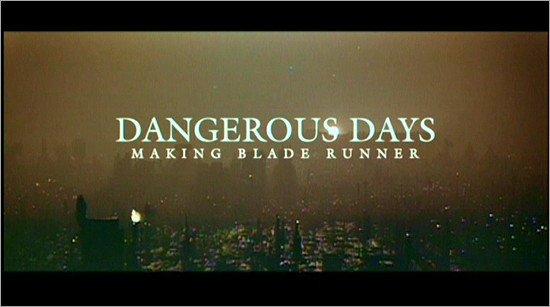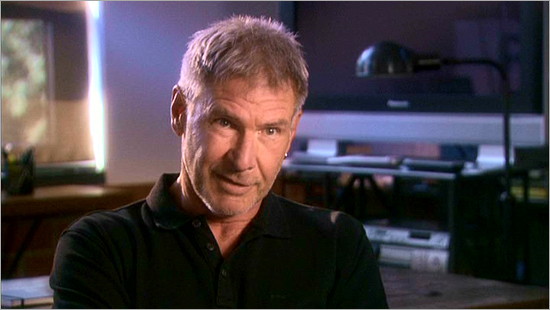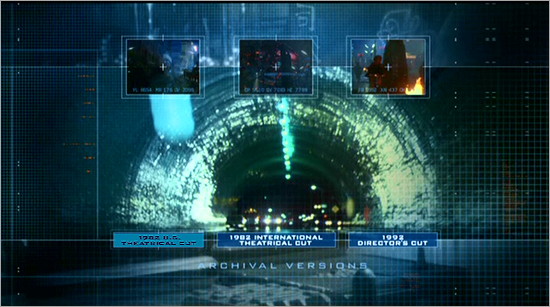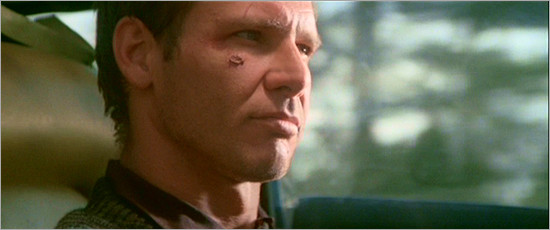Blade Runner: The Final Cut (Blu-ray Review)

Director
Ridley ScottRelease Date(s)
1982/1992/2007 (original BD release December 18, 2007)Studio(s)
The Ladd Company/The Blade Runner Partnership (Warner Bros.)- Film/Program Grade: See Below
- Video Grade: See Below
- Audio Grade: See Below
- Extras Grade: A+
- Overall Grade: A+
Review
Disc Two – Dangerous Days: Making Blade Runner
Program Rating: A
Video/Audio Ratings (DVD): B/B
In terms of bonus content, so much of what’s available on these discs will astonish even the most diehard fan. Nowhere is that more obvious than here on Disc Two, which features a new, 214-minute documentary on the making of the film, entitled Dangerous Days, created by Charles de Lauzirika (Ridley Scott’s longtime special edition producer, whose previous work includes The Alien Quadrilogy, the Kingdom of Heaven: Director’s Cut, the Black Hawk Down: Deluxe Edition, the Gladiator: Extended Edition and the Legend: Ultimate Edition, among others).
Dangerous Days covers just about everything you’ve ever wanted to know about the making of this film. Over eighty original cast and crew members were interviewed for the documentary, including Scott, both Harrison Ford and Rutger Hauer, producers Bud Yorkin and Jerry Perenchio, and many, many others. Seemingly everyone involved in the production weighs in here – even actress Stacey Nelkin, who was originally set to play Mary, the infamous “sixth Replicant.”

The documentary takes you through the making of Blade Runner, from start to finish. You’ll learn how the idea originated and developed, and how each participant came to be involved. You’ll learn about the process of translating Philip K. Dick’s novel into a script, as well as other inspirations for the look and feel of the film. You’ll see storyboards of Scott’s originally planned “farmhouse” opening, and learn about the unrealized “Snake Pit” sequence that would have featured Zhora dancing on stage. You’ll get to see and hear people describe what it was like to be involved in the production. Syd Mead and other artists comment on the production design. Douglas Trumbull, David Dryer and other effects crew members talk about how the stunning miniatures were created. You’ll get a blow-by-blow account of all the difficulties that occurred, and the various power struggles that developed throughout the shoot. You’ll even learn how the infamous Deckard narration became a part of the film, from no less an authority than Harrison Ford himself.

In one of the best sequences of the documentary, Ford describes how he was required to record new narration while Scott was away editing the film – narration written by someone hired by the producers without the director’s knowledge. You’ll actually get to hear outtakes from the recording sessions, in which Ford jokes about how absurd the narration is! The documentary then goes on to examine Blade Runner’s theatrical release, the initial polarizing reaction to it, its strange journey and growth in popularity over the years, and its powerful influence on later films, complete with additional interviews with L.A. Times film critic Kenneth Turan and directors like Frank Darabont, Guillermo del Toro, Joseph Kahn and Mark Romanek.
It should be noted that throughout the documentary, you’re constantly being treated to never-before-seen production material, including behind-the-scenes footage shot on the set, rare production photos and artwork, and even unused film footage (such as alternate takes and different camera angles). As a result, Dangerous Days gives you a broader, richer look at the world of the Blade Runner than fans could ever in their wildest dreams have imagined.

No matter which version of The Final Cut you choose, Dangerous Days is only included as a standard-definition DVD disc. In terms of video quality, the entire documentary is presented in very good looking anamorphic widescreen. In addition, all of the interviews and new footage were shot in high-definition, and much of the other film-based footage was transferred in high-def as well, so the overall video quality is excellent throughout. Some of the vintage on-set footage is a little dingy looking, but it never distracts from the presentation. In fact, you’re more likely to be so engrossed in the material that you’ll hardly notice such things. The audio is solid Dolby Digital 2.0 stereo, and in a nice touch, optional subtitles are also available for those who might need them (English for the hearing impaired, French and Spanish). The menu scheme is identical to Disc One. The documentary has 8 chapters. Theatrical trailers are also included on the disc for I Am Legend, Invasion, Fracture and Superman: Doomsday – not that you’ll really care.
Disc Three – Archival Versions
U.S. Theatrical Cut (1982)
International Cut (1982)
Director’s Cut (1992)
Film Ratings (82 TC/82 IC/92 DC): A-/A-/A
Video/Audio Ratings (Blu-ray Disc): B/B
Given the different versions of Blade Runner that have been available over the years, including them all in a single disc release is a challenge. Thankfully, Warner has used the seamless branching capabilities of Blu-ray to include all three legacy versions of the film on this one disc. Available here are the 1982 U.S. Theatrical Cut (117 minutes), the 1982 International Cut (118 minutes) and the 1992 Director’s Cut (117 minutes). You simply select the one you want from the disc’s opening menu. That takes you to a submenu where you can select the various options, start the film or watch Scott’s introduction (available for each version).

Diehard fans obviously know the differences between each version intimately, but for the uninitiated, here’s a quick primer: The 1982 U.S. Theatrical Cut features the Deckard voiceover narration and the infamous “happy” ending. The 1982 International Cut is basically the same as the Theatrical Cut, but with added and extended bits of violence. The 1992 Director’s Cut is a different animal altogether.

In the early 1990s, Warner noticed something of a resurgence in the film’s popularity (in large part due to the buzz in the fan community following an accidental public screening of the workprint). To take advantage of this, the so-called Director’s Cut version of the film was created and released into theaters in 1992. Though it wasn’t a true director’s cut, Scott was allowed some small degree of input, and he chose to remove Deckard’s much-maligned voiceover narration and the theatrical cut’s “happy” ending. He also added the infamous “unicorn” scene, which had originally been shot for the film, but was never included in any of the previous release prints.

The high-definition presentation on Blu-ray Disc is very good looking overall – not as good as The Final Cut, but very solid. It’s just a little softer looking than The Final Cut, with a little more grain visible and the occasional print artifact. The sound is just Dolby Digital 5.1, but it’s a very good mix. One last quick note: The BD features pop-up menus that allow you to select the various options. You can change versions of the film while you’re watching, but the player goes back to the beginning of the new version. When you first put the disc in your player, a menu screen asks you to select the version you want, and then off it goes.
Now let’s get into the nitty-gritty portion of the extras, available on Discs Four and Five...



